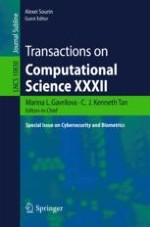This, the 32nd issue of the Transactions on Computational Science, focusses on cybersecurity and biometrics. The eight detailed papers cover the following topics: Multimodal Warnings for Distracted Smartphone Users on the Move; EEG-Based Mental Workload and Stress Monitoring of Crew Members in a Maritime Virtual Simulator; Detecting Web Defacement and Enabling Web-Content Regeneration; Software as a Weapon in the Context of (Inter)national Security; Multi-user Architecture and Multi-player Games; An Adaptive Discrete Wavelet Transform Based Face Recognition Approach; Synthesizing Images of Imagined Faces Based on Relevance Feedback; and Neurofeedback Training to Enhance the Focused Attention of Elite Rifle Shooters.
